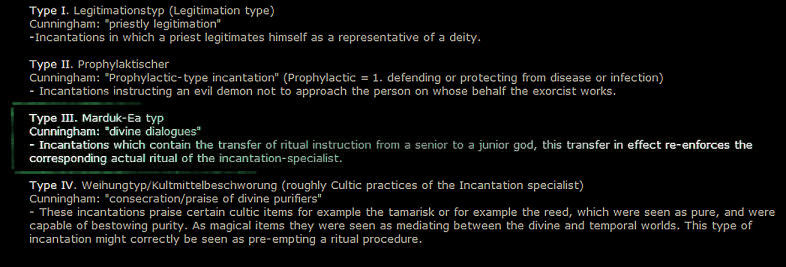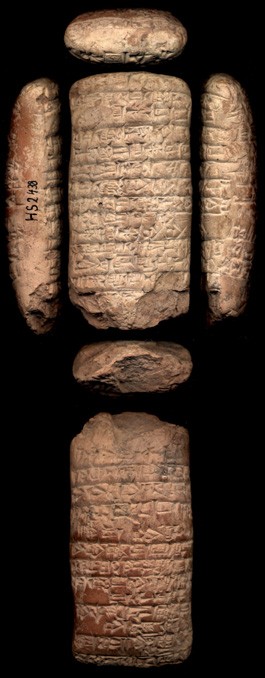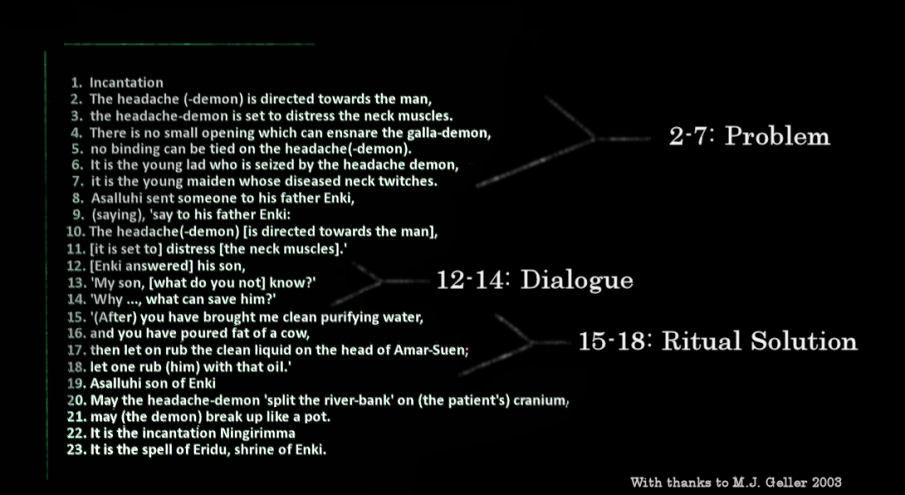Anatomy
of an Typ III Incantation text |
Brief note about Sumerian Incantations types: Adam Falkenstein in his 1931 "Haupttypen der sumerischen Beschwörungen" was the first to observe and record four principal categories of Sumerian incantation. Falkenstein studied the late Udug-hul incantations to make these distinctions, and his analysis has remained unsurpassed. The category of an incantation essentially derives from its focus, and by extension, the category of an incantation may also indicate at which point in the exorcistic proceedings it was to be used. Today we are focusing on the Typ III Marduk/EA incantation, see the highlighted area for definition below:
|
The Anatomy of a Typ III Incantation Text
-The Marduk-Ea typ incantation has been described as "important to literary study precisely because of its mixing of story, speech, and magical force. The result is a powerful, well-constructed, and strangely beautiful poetic composition. The "Marduk/Ea" incantations demonstrate an intimate connection between the religious, the magical, and the esthetic so complete that any attempt to pull away from the other will distort the whole (and remove the magic.)" (Kramer 1989 - see A).
The basic nature of these incantations as will be seen below, is that the patient is suffering from the influence of some demon or malignant force - the patient is sick. The junior god, Asalluhi (later called Marduk) see's the suffering, and either himself goes or sends a messanger to the senior god (Enki later called Ea.) Cunningham in his 1997 analysis of Incantation literature (B) sees these incantations in themselves to be examples of divine mediation, magic connecting divine and temporal worlds in order to produce efficacy (effect). In his words: "These narratives can be regarded as presenting mediation between the temporal and divine domains in three stages, with the sending of the messenger representing separation from the temporal domain, the meeting with [Enki] representing elision of the opposition between the two domains,and the performance of the ritual representing the transfer of that elision to the temporal domain." |
Structure of a Marduk-Ea typ incantation:
In the image below I have emphasized these 3 elements:
|
1:
en2-e2-nu-ru: translated "incantation". en2-e2-nu-ru
was a text convention, an initial rubric, used to identify the
content of the text to follow. This rubric told the ancient scribes
that this text was an incantation text. 8: Junior deity intervenes - In the Ur III period the role of 'junior deity' in these incantations is played by Asalluhi, the son of Enki whose city was Kuara near Eridu (later the god would be known by the name Marduk.) Asalluhi in this incantation type invarable notices the suffering of the patient, the problem, and brings it to the attention of the 'senior god' (Enki), in earlier incantations such as this one he would send a messenger although in later compositions he would appear before Enki personally. (Cunningham 1997). 9-10: Restating the problem - In a typical typ III incantation the problem that is given at the opening of the text is restated to the senior god. Among other things, this serves perhaps to reinforce that the scene has changed (from temporal to divine). 12-14: DIALOGUE (formulaic answer) - This part of the Typ III incantation is, as Kramer explains (1989) "the most conventional part" of the this type of incantation and consists of words like "My son! What do you now know! How can I add to your knowledge? What do you now know? How can I increase it? What I know, you know also. Go, my son!" While the senior god feigns a posture of equal knowledge with the junior god, this formulaic answer always precedes the direct transfer of magical knowledge (power) from the former to the latter. 17: Unusual reference to specific sufferer - In this line we see something that is *unusual* to incantation texts as a whole, in that this particular specimen is personalized - it is directed specifically at the headache demon afflicting the Ur III king Amar-Suen. This incantation is known also from later exemplars in which the wording is more general and directed at a nameless sufferer, and this is far more typical for incantation texts. On this particular point our text is exceptional therefore. 15-18: RITUAL SOLUTION - The centerpiece of this type of incantation, is when the instructions are given. Because Enki is given as speaking them, the instructions are imbued with a divine legitimation. A key understanding here, is that although ostensibly directed at Asalluhi, Enki's instructions we understand, were likely performed at the same time by the officiating priest as the incantation was uttered. The ritual here can therefore be seen as mimetic ritual - simply meaning that the action corresponds (mimics) the words of the spoken incantation. So the instructions of Enki represent the actual practice of the Sumerian ritualist, and each Marduk-Ea incantation is a rare glimpse. 19-21:
Concluding Theme/ Analogical language - Kramer 1989, chapter 7:
The author describes this section of the Marduk/Ea incantation
as the "concluding theme", that is, a few lines where
the demon or problem is described with "precative" forms
of the verb, and that these words when spoken are to be understood
as examples of "locutionary" speech, meaning the act
is there in the saying itself; as the author states "powerful
locutionary commands do not so much describe what will happen,
but make it happen. In other words, word and performance are one,
the very essence of magic." 22-23: Divine Legitimation - According to Cunningham 1997, when a incantation is concluded in this way it can be seen as a distinct form of 'divine legitimation', demonstrating again that the magical efficacy come from above. The incantation is not my incantation (is not mundane), it "is the incantation of Ningirimma" (it is that of the goddess of incantations - it is divine.) By assigning a divine origin to his words, the exorcist re-enforced their power.
|


